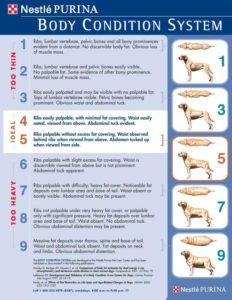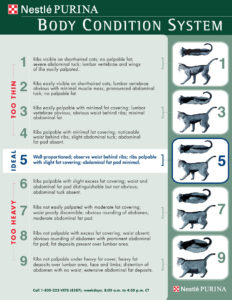What an animal weighs is just a number. The current trend in people is to use body composition, or “percent body fat.” This gives a much more accurate interpretation of a person’s build. You can have two 5’8″, 170 lb women. One can be a couch potato with no muscle, and she may be 38% fat, which is obese. The other may lift weights, work out often, and be 18% body fat, which is actually quite trim.
A similar concept of assessment is used in dogs and cats. No, I don’t get out my calipers and start pinching. We use a “body condition score.” This is a rating on a scale of 1-9 of the condition of your pet. On this scale, a 1 is underweight to the point of emaciation, and a 9 is obese. Hence, a 5 is ideal. How do I tell? I don’t need the number on the scale! It’s all about fat composition. I should be able to feel the ribs without hunting for 30 seconds. A waistline should be visible when I look at the pet from the top. Obviously, different breeds have difference builds, and I take this into account when determining this. I like the system that Purina advocates, scoring them on a scale of 1-9. (There are other systems out there as well that score from 1-5. There’s no right or wrong, just personal preference.) Below is the 1-9 scale.
Larger, more clear images, are here for dogs, and here for cats.

Purina provides these charts for veterinarians to use to teach clients!

Here’s the cool part – that number I assign correlates to a percent body fat! A dog who is ideal will be 15-25% body fat, depending on breed. A dog who scores a 7 out of 9 is about 35-40% body fat, and a 9 out of 9 is about 45-50% fat.
Here’s what’s sad. Some animals are so obese, they are literally off the chart! So, the University of Tennessee recently published new guidelines for dogs and cats, allowing for animals to be rated up to 75% body fat. We are still using the 1-9 scale, but this allows for more detailed assessment, as well as guidance to what the pet SHOULD weigh. They offer a way to estimate the percentage body fat for a pet who scores a 10 or 11 our of 9. If you’re thinking “these animals are 70% body fat?” That is very possible, unfortunately. And yes, I have, sadly, seen many of those.
So check it out, and if you aren’t sure, your vet will be happy to show you! I have many clients who think fat rolls that are tight under the skin are “muscle” or “ribs.” Some animals have tricky body shapes. And yes, there is a small amount of subjectivity to it. For fun, try to determine what score your pet gets before your vet clinic, and see how close you and your vet come!